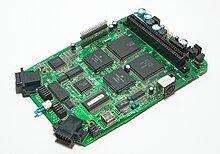Sega Multi-Mega: Difference between revisions
No edit summary |
No edit summary |
||
| Line 1: | Line 1: | ||
The sega Mutli Mega (Sega CDX in the USA) |
|||
[[Image:Sega Multi Mega.jpg|right|thumb|Sega Multi Mega (1994)]] |
[[Image:Sega Multi Mega.jpg|right|thumb|Sega Multi Mega (1994)]] |
||
The '''Sega CDX''' (or the '''Sega Multi Mega''' in Europe) was a 16-bit video game console released in 1994, combining the [[Genesis]] (Multi Mega in Europe) and one of its add-ons, the [[Sega CD]] (Mega CD in Europe), into a single compact unit as a final attempt by [[Sega]] to encourage consumer interest in its fledgling Sega-CD format. It was sold under the name '''Multi-Mega''' in Europe (350 [[Pound sterling|GBP]] or 999 [[German mark|DM]]), '''Genesis CDX''' in [[North America]] (399 [[United States dollar|USD]]) and '''Multi-Mega CDX''' in [[Brazil]]. |
The '''Sega CDX''' (or the '''Sega Multi Mega''' in Europe) was a 16-bit video game console released in 1994, combining the [[Genesis]] (Multi Mega in Europe) and one of its add-ons, the [[Sega CD]] (Mega CD in Europe), into a single compact unit as a final attempt by [[Sega]] to encourage consumer interest in its fledgling Sega-CD format. It was sold under the name '''Multi-Mega''' in Europe (350 [[Pound sterling|GBP]] or 999 [[German mark|DM]]), '''Genesis CDX''' in [[North America]] (399 [[United States dollar|USD]]) and '''Multi-Mega CDX''' in [[Brazil]]. |
||
Revision as of 23:49, 15 February 2010
The sega Mutli Mega (Sega CDX in the USA)

The Sega CDX (or the Sega Multi Mega in Europe) was a 16-bit video game console released in 1994, combining the Genesis (Multi Mega in Europe) and one of its add-ons, the Sega CD (Mega CD in Europe), into a single compact unit as a final attempt by Sega to encourage consumer interest in its fledgling Sega-CD format. It was sold under the name Multi-Mega in Europe (350 GBP or 999 DM), Genesis CDX in North America (399 USD) and Multi-Mega CDX in Brazil.
Capabilities
The Sega CDX could play both Genesis and Sega CD games, thanks to its rear-mounted cartridge slot and its front-mounted flip-top CD drive. Like the Sega CD, it was also capable of playing audio and CD+G format CDs. Unlike the Sega CD, its compact size and addition of a headphone port enabled it to play audio CDs on the move, powered by two AA batteries. However, unless high end batteries such as lithiums were used, it would drain the batteries fairly quickly. The unit featured front-mounted CD control buttons as well as a backlit LCD screen to display the track number. An extra line-out port was provided for connection to stereo equipment. However, games could only be played while the unit was powered by its main PSU and connected to a television, unlike the portable Sega Nomad.
Compatibility with Sega 32X

There is some confusion as to whether the Sega 32X add-on actually works with the Sega CDX. While Sega stated in the 32X manual that it does work, it added an insert into the North American retail box retracting this statement. This was likely due to the Genesis/32X combination never receiving FCC approval for use in the United States. Advertisements for the Mega Drive 32X in Europe, however, where it was often shown attached to a Multi-Mega, suggest otherwise. Despite the lack of a Sega's approval, the 32X is compatible with the CDX if properly connected.
Datel CDX cartridge
An adapter cartridge from Datel, also called the CDX, often causes confusion due to its name and function. This cartridge was sold in Europe and allowed Mega-CD games from all regions to be played on any Mega-CD.
External links
- Sega 16 Sega-16 article on the Sega CDX.
